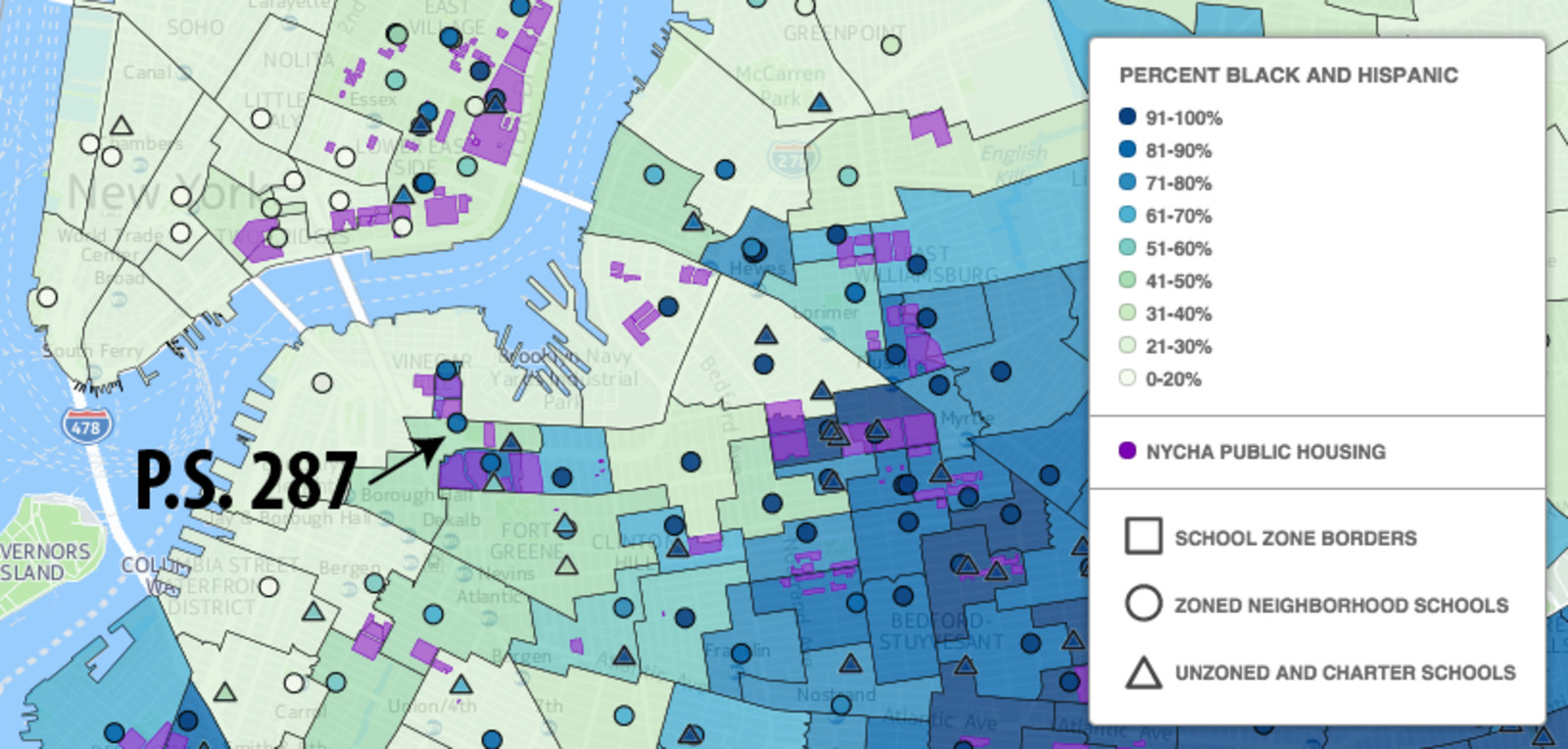Report: Schools are more segregated than neighborhoods

by Clara Hemphill and Nicole Mader
In multi-ethnic New York City, why are so many elementary schools segregated by race and class? For years, school officials and researchers have assumed that school segregation merely reflects segregated housing patterns—because most children attend their zoned neighborhood schools.
However, new research by The New School's Center for New York City Affairs demonstrates that school segregation is not always the result of housing patterns. In fact, as these interactive maps show, there are dozens of high-poverty elementary schools that serve mostly black and Latino children that are located in far more racially and economically mixed neighborhoods.
In Harlem, for example, the estimated household income of children enrolled at PS 125 is barely half that of all the households in the school zone, based on median household income estimates from the most recent American Community Survey by the U.S. Census. PS 125's pupils are 84 percent black and Latino; the proportion of black and Latino people living in the school's attendance zone is just 37 percent.
In downtown Brooklyn, the estimated household income of children enrolled at PS 287 is less than half that of all households in the school attendance zone. The school enrollment is 89 percent black and Latino; the zone, just 43 percent.
This is not to minimize the impact of housing segregation. As these maps show, large swaths of the city have high concentrations of poverty. Many high-poverty neighborhoods are overwhelming black and Latino. Student enrollment in hundreds of schools reflects that reality. But these maps also demonstrate that the city's schools are even more economically and racially segregated than the neighborhoods—and for economically disadvantaged students, that usually translates to inferior education.
This analysis suggests that many parents, dissatisfied with their neighborhood schools, vote with their feet and send their children to public gifted programs, schools of choice, charter schools or private schools. It follows that some racial and economic integration can be achieved without changing zone lines or assigning kids to schools outside their neighborhoods—measures which are often politically fraught. The key is to improve these schools to motivate more middle class parents who live in economically mixed neighborhoods (or white and Asian parents living in racially mixed neighborhoods) to send their children to the neighborhood schools. Research shows that attracting higher-income students to such schools typically improves classroom education for all the students.
The two schools we've highlighted—PS 125 and PS 287—extreme examples. But our analysis found that 124 of the city's 734 neighborhood elementary schools—schools with a total enrollment of 62,607—are substantially poorer than their school zones. For these schools, the estimated household income of the zone is at least 20 percent higher than the estimated household income of the children enrolled.
The city's schools are divided by race as well as by income. Some 332 of the city's 734 neighborhood elementary schools have enrollments that are more than 90 percent black and Latino. Most of these are in neighborhoods that are also overwhelming black and Latino.
Nonetheless, we found 59 schools with enrollments of more than 90 percent black and Latino students in neighborhoods that are racially mixed, that is, neighborhoods that are less than 80 percent black and Latino. These schools have a combined enrollment of 28,175 children.
These maps are the first part of a two-year research project, begun in July 2015, analyzing the causes of racial and economic segregation in the city's elementary schools. Over the next 18 months, we plan to identify schools that were once highly segregated and that are now integrated to see what lessons might be learned. We will visit some of the city's racially and economically segregated schools in integrated neighborhoods to suggest ways in which they might become integrated.
Please Post Comments